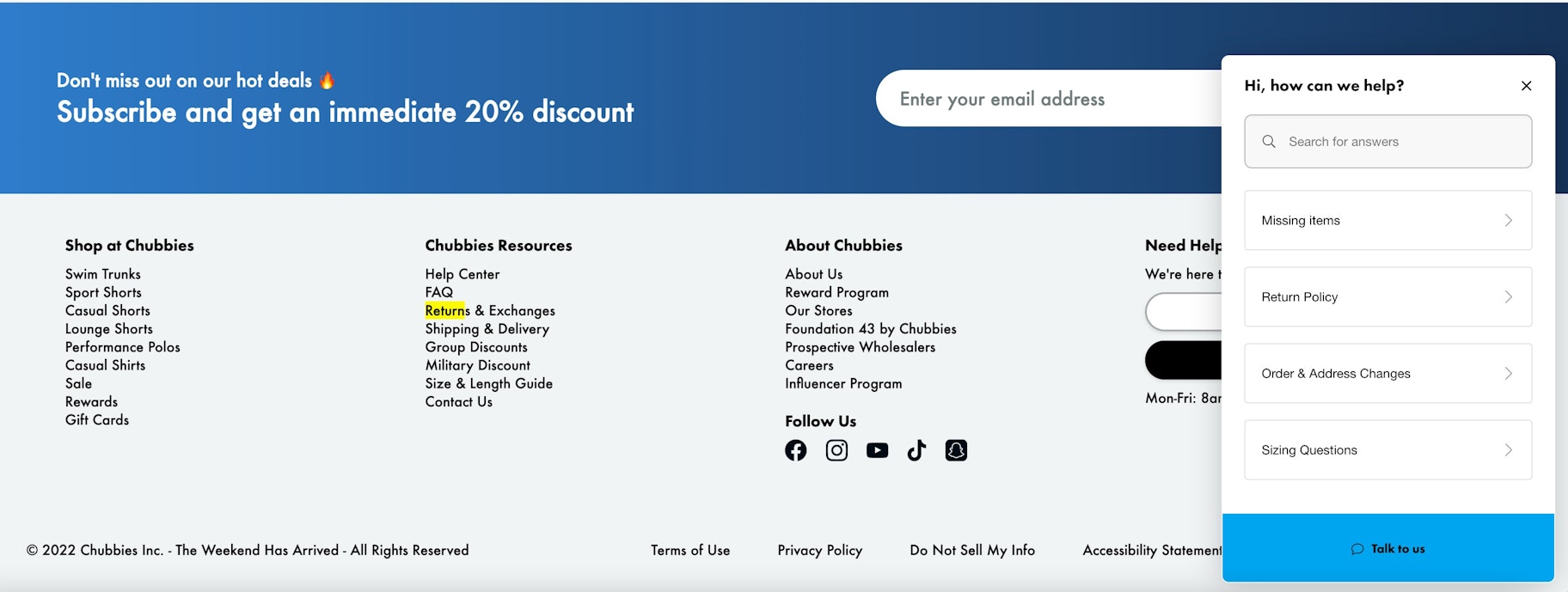With a dramatic boost in online purchases comes a subsequent boost in returns. While no business is overjoyed at the thought of returns, it’s a necessary part of the process. The best thing you can do is create a smooth and painless return process, and that starts with your return policy.
You might not think it’s incredibly important, but when you zoom out and look at the importance of the customer returns, it’s easy to see why. In recent research from Klarna, 84% of online shoppers said they’d stop buying from a company after just one unsatisfying return experience. On the flip side: a good experience can turn a one-time shopper into a lifelong customer.
That’s why your return policy needs to be clear, easy to read, and easy to -find. Let’s look at how to set your returns process—and your business as a whole—up for success.



What is a return policy?

Return policies are the rules that define how customers can return or exchange unwanted items they purchased. Retailers can create a return policy to inform customers what goods can be returned and for what reasons, as well as the time frame over which they accept the returns.
→ Click Here to Launch Your Online Business with Shopify
Why have a return policy?
A good return policy helps a business create trust with its customers. According to Pitney Bowes, 54% of shoppers are unlikely to buy a product they want if the merchant has an unclear or poor return policy. That’s why many retailers now provide customers with a clear and consistent way to return a purchased item.
But don’t returns go against the idea of profitability? Technically yes—but the improved customer experience is more likely to drive retention and long-term revenue growth.
Moreover, offering easy returns to customers will benefit your reputation. With 66% of people saying they trust consumer opinions posted online, any testimonials and word-of-mouth recommendations about your returns experience will pay off as free marketing for your business.
How to write a return policy (+ free return policy template)
Your return policy is literally a contract with your customer. It explains how things will go and what to expect, setting the stage for a smooth process for everyone involved. Plus, it benefits you on the operations side, helping you to systematize the process and avoid doing anything on a bespoke basis (which can really mess up your workflows!).
The good news is that there’s no single correct way to write a return policy. It all depends on how you want to do things. But there are some points that you need to make sure you cover in order to ensure customer satisfaction. Consider:
- Which items in your store are eligible for return or exchange. Note which items are ineligible, like sale items, cosmetics, undergarments, etc.
- The time limit for returns and exchanges, e.g., 30 days after delivery or purchase date.
- Any requirements for the condition of the items upon return, e.g., unopened, original packaging, lightly worn, with tags on, etc.
- How customers will be reimbursed, like refund to the original form of payment, store credit, a product of equal value, etc.
- Any fees they’ll need to cover, like return shipping or restocking fees. Be very clear about this, or you may have some frustrated customers on your hands.
- How to get the returns process started, e.g., email customer service at a specific address, submit a return request on a specific page of your website, etc. Be sure to link directly to where they need to go.
- If you’re selling through a marketplace or other sales channel, make sure you’re considering their policies. They may override your own.
- How you handle returns for lost or damaged items.
- Bonus: How long it takes for them to receive their refund, exchange, or credit.
Return policy template for ecommerce stores
Unsure where to start? Just copy and paste this return policy template on your website and replace it with your own details. Of course, feel free to slice and dice as much as you see fit. Remember, there’s no single right way to make an ecommerce return policy.
Looking to return or exchange an item? We’ve got you covered. We want you to be completely satisfied with your purchase, so you can return any eligible product for free, within 30 days after it was delivered to you. If your items meet the eligibility requirements, you can request:
- A refund via your original form of payment
- Exchange for a different item of the same value
- Store credit to snag something else in our store
Which items are eligible for return or exchange?
Here are the eligibility requirements:
- Discounted or sale items are ineligible—they cannot be returned or exchanged.
- All returns or exchanges must be in their original packaging, with tags.
- All returns or exchanges must be in brand new condition, with no signs of use or wear.
- All returns or exchanges must be received by us within 30 days of your package delivery.
How do I return my item(s)?
The process for exchanging or returning an item is simple:
- Visit our returns page: www.yourstore.com/returns
- Click the “Start a return or exchange” button.
- Fill in your confirmation number that we sent you via email after you made the purchase.
- We’ll then send you a shipping label via email. Print it and tape it to the outside of the package.
- Drop it off at your nearest UPS store and you’re done.
Where can I reach you with questions or comments?
If you have any questions, email us at support@yourstore.com or call 1-800-555-5555.
Where to put a standard return policy
After writing your return policy, put it in an area where it’s clearly visible. Customers must be able to see it before they purchase—hiding the policy in fine print can make them distrust your brand. Consider including links to your policy in several hard-to-miss places throughout your site to avoid going back and forth with shoppers who did not find the policy.
Ideally, you’ll want to list your policy in the following places:
- Website banner
- Website footer
- Product page
- FAQ page
- Website chat
- Order notification emails
For a great return policy example, check out Chubbies’ website.

The online clothing retailer directs customers to its return and exchange policy through its website chat. Customers can also start a refund with one click.
Tips for more profitable returns
Returns don’t come cheap to any business, but there are a few ways you can minimize your losses while offering them to your customers.
1. Sell product warranties
One risk companies often face when a customer chooses to return a product is whether or not they will be able to resell the item.
It could be a couple of weeks before a returned product re-enters stock, and there’s no guarantee that it will arrive in pristine condition (the time spent in transit and unpacking can often leave goods damaged).
If the product is expensive, you may want to consider selling a warranty rather than accepting returns. Product warranties secure merchants against paying to replace damaged goods and avoid disputes around who is to blame. You can sell warranties through Clyde, a tool that adds order protection on your product page:
2. Turn returns into exchanges
Although both returns and exchanges impact a company’s profitability, the loss is less severe with an exchange. That’s because you can offer a replacement product with a strong margin instead of a full refund, which means you can offset the loss from the returned product.
But how do you encourage exchanges over returns and refunds? One way is to make an offer to cover return shipping costs if the customer chooses to exchange the item. With this approach, you’ll also get another shot at satisfying the customer—do that successfully and you’ll improve their lifetime value.
3. Cross-sell or upsell exchange requests
Another ecommerce returns best practice is to cross-sell and upsell exchange requests.
When customers return to your website to use their store credit, show them new items they did not purchase the first time that complement what they’re exchanging for. In case of upselling, you can make a personalized recommendation for a higher-priced product that fulfills the requirements that weren’t satisfied with the first purchase.
You can use Shopify apps like PX Related Products to show customers additional items they might be interested in purchasing. When you look at every exchange as a new opportunity to increase your order value, the reason to turn more returns into exchanges becomes clear.
Good return policy, good experience
In today’s high-return ecommerce landscape, you’ll need to nail your return process to keep your customers happy. And that all starts with your return policy. Make sure it’s clear, fair, and easy to find on your website. This way, you’ll get off on the right foot with your customers by helping to manage their expectations. That’s the first step to making them loyal for life.
Return policy FAQ
What is a return and refund policy?
A return and refund policy is an agreement between a company and its customers. You can create one for your ecommerce store to provide information such as:
- Who covers the shipping fees for returns
- How many days do customers have to return a product
- What do you offer refunds for
- How you give refunds, whether through debit card, credit card, or store credit
- How many business days it takes to receive a refund
How do I make a return policy?
- Be clear and concise when drafting your return policy.
- Take responsibility for returns.
- Get your teams up to date with your return and refund policy.
- Make it easy for customers to access your ecommerce return policy.
- Give examples of your policy in action.
Are refunds legally required?
While the US does not have federal refund laws, and many states don’t legally require refunds, it’s still a good idea to have a return and refund policy. With a no return policy, customers are likely to abandon the purchase and buy from elsewhere.






